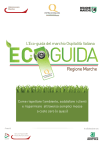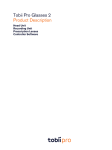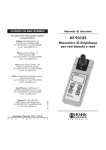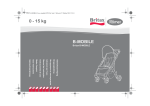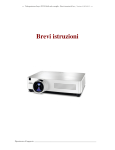Download Istruzioni generali di utilizzo General instructions for use
Transcript
1 Istruzioni generali di utilizzo General instructions for use MAX 15kg 0-3 MAX 12kg L>80cm MAX 15kg TYPA – L2 BERBER CARLO TYPA – L3 MAXI COSI CYBEX TYPA – L4 click 7 BOBOSTELLO RAMATTI Service IT 7 Istruzioni generali di utilizzo. Importanti informazioni di sicurezza. ATTENZIONE! Questo manuale è da conservare ed utilizzare come riferimento futuro. AVVERTENZA: Non lasciare mai il bambino incustodito. Prima dell’utilizzo, accertarsi che tutte le componenti essenziali e le chiusure funzionino correttamente. Non posizionare il bambino all’interno del prodotto durante l’apertura o la chiusura della carrozzina. Non permettere al bambino di giocare con questo prodotto. Il prodotto non è adatto alla corsa o al pattinaggio. Utilizzare sempre il freno nel posizionare il bambino all’interno e nel prelevarlo dall’attrezzatura. Ogni carico che venga applicato alla maniglia della carrozzina, al retro della seduta del passeggino o da entrambi i lati del prodotto ne compromette la stabilità. Il prodotto può trasportare soltanto un bambino e può essere utilizzato solo per la fascia di età specificata. 12 IT IT 8 9 MAX 12kg L>80cm MAX 9kg L<80cm MAX 15kg + Non utilizzare materassini di spessore superiore a 25 mm. Questo prodotto è adatto a bambini non in grado di sedersi, girarsi o alzarsi sulle mani o sulle ginocchia autonomamente, per un peso massimo di 12 kg. Non utilizzare materassini di spessore superiore a 25 mm. Questo prodotto è adatto a bambini non in grado di sedersi, girarsi o alzarsi sulle mani o sulle ginocchia autonomamente, per un peso massimo di 9 kg. Utilizzare sempre la cintura di sicurezza. Prima di utilizzare l’attrezzatura, controllare che la navicella, la seduta o il seggiolino auto siano montati correttamente sul telaio. 1. Prima dell’utilizzo si prega di leggere con attenzione il presente manuale e di conservarlo. La sicurezza del bambino può risultare compromessa qualora le raccomandazioni indicate nel presente manuale non vengano seguite. Il produttore non può ritenersi responsabile per le conseguenze della mancata osservazione delle indicazioni, avvertenze e raccomandazioni incluse nella documentazione relativa al prodotto. 2. Dopo l’acquisto sottoporre a costante controllo e revisione tutti i componenti specificati dal produttore nel manuale di servizio. Questa attrezzatura richiede una regolare manutenzione da parte dell’utilizzatore. È responsabilità dell’utilizzatore sottoporre il prodotto a controlli e manutenzione di routine al fine di evitare danni al veicolo e/o lesioni al bambino. 3. La struttura del prodotto consente la regolazione in altezza del maniglione. Al fine di regolarne l’altezza, tenere premuti gli appositi pulsanti su entrambi i lati della barra, selezionare l’altezza desiderata e poi rilasciare i pulsanti. Dopo avere regolato l’altezza della struttura, si raccomanda di impugnare il maniglione nella parte superiore e scuotere la struttura un paio di volte, al fine di accertarsi che i meccanismi di aggancio funzionino correttamente. 4. Per prodotti muniti di barra di sicurezza rimovibile, assicurarsi che le mani del bimbo non siano fuori dalla linea esterna della seduta durante il posizionamento o la rimozione della barra. Dopo ogni cambio di regolazione della barra di sicurezza si raccomanda di verificare il funzionamento del meccanismo di fissaggio automatico, tirando la barra verso l’alto e verso il basso più volte. 5. Durante il cambio di posizione dello schienale o della navicella, prestare attenzione alle mani e alla testa del bambino. 6. Il prodotto è munito di poggiapiedi regolabile. Per abbassarlo, premere entrambi i pulsanti ai lati di esso, regolarne la posizione e poi rilasciare i pulsanti. Il poggiapiedi è munito di sistema di auto-bloccaggio che non necessita la pressione dei pulsanti di regolazione per alzarlo. 7. Non permettere al bambino di stare in piedi o seduto sopra al poggiapiedi. L’impatto di un carico maggiore su di esso può danneggiarne il meccanismo di bloccaggio. Nel caso in cui il bambino salga e scenda indipendentemente dal passeggino, regolare il poggiapiedi nella posizione più bassa. IT IT 10 8. Il passeggino è dotato di schienale regolabile. Per inclinarlo nella posizione di mezza seduta o distesa, tirare verso l’alto la maniglia situata nella parte posteriore dello schienale, selezionare la posizione desiderata e rilasciare la maniglia. Lo schienale è dotato di meccanismo a molla autobloccante che non necessita il tiraggio della maniglia per alzare lo schienale dalla posizione distesa a quella di seduta. 9. Non consentire al bambino di stare in piedi sulla seduta del passeggino, poiché ciò può compromettere la stabilità del prodotto e causarne la caduta. 10. Non movimentare il prodotto tenendolo per la cappottina, per la parte superiore dello schienale, per il poggiapiedi o per la navicella. Non utilizzare il prodotto su scalini né lasciarne la presa, con il bimbo all’interno, su superfici irregolari, neanche con il freno in posizione di blocco, al fine di evitarne lo scivolamento e la caduta. Per il trasporto del prodotto su o giù per le scale o per il suo posizionamento nei mezzi pubblici è consigliabile l’aiuto di un’altra persona. La persona che regge la maniglia passerà l’ostacolo per prima, mentre chi regge l’altra estremità del prodotto dovrà afferrarlo per una parte stabile del telaio, al fine di evitarne la caduta. Nel trasporto del prodotto per le scale verso il basso, è consigliabile che la persona che sta aiutando scenda per prima. 11. Quando il prodotto non è in movimento, si consiglia di mettere sempre il freno in posizione di blocco. Per utilizzare il freno abbassare l’apposita leva; si consiglia di verificarne sempre il funzionamento. Prima di movimentare il prodotto, assicurarsi che le ruote non siano in posizione di blocco, per evitare danni agli elementi di bloccaggio. 12. Nell’attraversamento di ostacoli di vario livello (es. porte con gradini) posizionare le due ruote posteriori alla stessa angolazione e simultaneamente spingere la barra manuale verso il basso nel passando l’ostacolo con le ruote anteriori. Per l’attraversamento di ostacoli di una certa altezza, come ad esempio i bordi di un marciapiede, posizionare le ruote anteriori del prodotto leggermente al di sopra del livello dell’ostacolo, premendo simultaneamente la barra manuale verso il basso e tirandola verso sé, spostare le ruote posteriori vicino all’ostacolo, abbassare le ruote anteriori e poi spostare le ruote posteriori al di sopra dell’ostacolo sollevando il prodotto. Ogni collisione con oggetti o superfici dure può 11 causare danno e/o deformazione agli elementi di connessione del telaio e causarne una mancanza di allineamento. 13. Il carico della cesta fissata alla struttura non deve eccedere i 2 kg di peso. La borsa portaoggetti da appendere al maniglione regolabile può sopportare un peso massimo di 1,5 kg. Le tasche del passeggino sono a mero scopo decorativo e non possono contenere oggetti di peso superiore a 0,15 kg per ciascuna tasca, o 0,35 kg complessivi. 14. Mantenere pulito il prodotto ed i suoi elementi. Rimuovere le impurità dal telaio preferibilmente con una spugna inumidita con acqua e asciugarlo preferibilmente con panni in cotone. Non utilizzare prodotti di pulizia aggressivi o caustici poiché potrebbero danneggiare gli elementi del passeggino, causando graffi, decolorazione dei tessuti o altri effetti indesiderati. Si consiglia di utilizzare prodotti di pulizia che siano appropriati per la superficie da trattare. In caso di macchie sulla cappottina, utilizzare una spugna umida con l’aggiunta di un prodotto di pulizia delicato. Evitare di inumidire eccessivamente la seduta del passeggino, la parte inferiore della carrozzina e della borsa (nelle attrezzature che ne siano dotate) per evitare la deformazione degli elementi di montaggio. 15. Al fine di evitare gocciolamenti o macchie d’acqua che potrebbero essere causate, ad esempio, dalla pioggia, è necessario coprire l’intero prodotto con la cappotta antipioggia. Si raccomanda inoltre di proteggere il prodotto dall’eccessiva esposizione ai raggi solari. Il produttore non può ritenersi responsabile per danni dovuti al deterioramento della cappottina che risultino dalla mancata osservazione di quanto sopra indicato. 16. Prima del montaggio e dello smontaggio delle ruote, spingere verso l’alto il meccanismo di bloccaggio del freno. Si raccomanda di mantenere pulita la struttura del passeggino. Nel caso in cui il prodotto sia dotato di ruote prive di cuscinetti, è necessario procedere alla lubrificazione degli assiali utilizzando materiali quali grasso oppure olio da macchina, al fine di ridurre l’attrito alle estremità. Nei modelli dotati di ruote con cuscinetti, soffiare con dell’aria compressa prima di utilizzare agenti lubrificanti quali ad esempio WD40. In caso di ruote gonfiabili, raccomandiamo che la pressione interna venga mantenuta ad un livello costante e mai eccedente le 0,6 atmosfere; attenersi in ogni caso ai valori riportati sulla spalla del copertone. IT IT 12 17. AVVERTENZA: abbiate cura di tenere pulito, utilizzando una pistola ad aria compressa e lubrificato il meccanismo del freno posteriore, utilizzando agenti lubrificanti quali ad esempio WD40, al fine di evitare l’indurimento dei pedali e la rottura/consumo dei dischi freno. 18. AVVERTENZA: non utilizzare accessori o parti di ricambio che il produttore e/o il distributore non abbiano espressamente approvato. 19. AVVERTENZA: non chiudere il telaio con la seduta, abbiate cura di rimuoverla attraverso i meccanismi di sgancio. 20. AVVERTENZA: non chiudere il telaio senza aver proceduto allo sblocco di entrambe le ruote anteriori, avendo cura di posizionarle verso l’esterno. 21. In caso di telaio munito di fori per il montaggio del seggiolino auto, non utilizzare connettori che non siano stati espressamente approvati dal produttore o dal distributore. 22. Non utilizzare adattatori per il seggiolino auto che il produttore o distributore non abbiano espressamente autorizzato. AVVERTENZA: prima dell’uso, accertarsi che i dispositivi di connessione del seggiolino siano correttamente innestati. 23. Non utilizzare il seggiolino auto montato su telaio per il riposo prolungato del bimbo. Per il sonno del bimbo, utilizzare sempre la navicella/carrozzina. 24. È consigliabile posizionare il seggiolino/ovetto auto su telaio nella direzione contraria al senso di marcia (fronte mamma) al fine di osservare più facilmente il bimbo all’interno del prodotto. 25. Nel caso di attrezzature per bambini dalla nascita in poi, si raccomanda di collocarli sempre in posizione distesa. 26. In caso di passeggini muniti di maniglie di sicurezza, accertarsi che esse siano sempre posizionate all’esterno del passeggino quando in uso. 27. Per ogni riparazione in garanzia ed extra-garanzia, utilizzare esclusivamente le parti di ricambio fornite o raccomandate dal produttore o dal distributore. EN 13 General instructions for use. Important safety information. IMPORTANT! Keep this manual for future reference. WARNING! Never leave the child unattended. Before use, make sure that all essential components & locking devices are functioning correctly. No child is to be placed in the vehicle when folding or unfolding the pram. Do not let your child play with this product. This product is not suitable for running or skating. Always engage the brake when placing the child in and taking the child out of the pram. Any load attached to the handle/back of the seat unit or both sides of the pram affects the stability of the vehicle. Pram is only suitable for specified number of children and can only be used for stated age groups. 12 EN EN 14 15 MAX 12kg L>80cm MAX 9kg L<80cm MAX 15kg + This product is suitable for children who cannot sit unaided, turn and climb on their hands and knees with the maximum weight 12 kg. Do not add mattress thicker than 25 mm. This product is suitable for children who cannot sit unaided, turn and climb on their hands and knees with the maximum weight 9 kg. Do not add mattress thicker than 25 mm. Always use asafety harness. Before using the pram, check if the bassinet, seat or car seat are correctly mounted to the chassis. 1. Before use, read the following manual carefully and keep it. The safety of the child may be compromised if the recommendations included in this manual are not followed. The manufacturer of the pram is not responsible for effects from not following notes, warnings and recommendations included in the product documentation. 2. After purchase maintain all the components specified by the manufacturer in the manual Service Department (SERVICE) before using the pram. This vehicle requires regular maintenance by the user. It is the user’s responsibility to undertake routine inspection and maintenance of the vehicle in order to avoid damage to the vehicle and/or injury to the child. 3. Pram handle tube height adjustment. To change the height of the pram handle tube press and hold buttons on both sides of the handle tube, select the required height and release both buttons. After adjusting the height of the handle tube, hold it in the upper part and move it twice up and down to make sure the locks function correctly. 4. In the case of prams equipped with transferable handle tube, ensure that the child’s hands are not outside the internal outline ofthe seat when changing the handle tube position. After each hange of the handle tube position, check the effectiveness of the self fastening locking mechanism by pulling the handle tube up and down several times. 5. When changing the position of the backrest or the bassinet, pay attention to child’s hands and head. 6. Footrest adjustment.The pram is equipped with adjustable footrest. To lower the footrest press the adjustment buttons on both sides of the footrest, adjust the footrest position and release the buttons. The footrest is equipped with an auto-lock system that does not require the buttons to be released when lifting the footrest. 7. Do not allow the child to stand or sit on the footrest. The impact of a larger load on the footrest may cause damage to the locking mechanisms. When the child independently gets in and out of the stroller, position the footrest to its lower position. 8. Backrest adjustment in the stroller version. The stroller seat is equipped with an adjustable backrest. To lower the backrest to halfsitting EN EN 16 or to the lying position, pull the handle in the back part of the backrest upwards, select the required position and release the handle. The backrest is equipped with a spring-loaded auto-lock mechanism that does not require the handle to be lifted when lifting the backrest from lying to sitting position. 9. Do not allow the child to stand on the seat as it may damage the stability of the stroller and cause the stroller to fall down. 10. Do not carry the pram holding the hood, upper edge of the backrest, footrest or the element creating the pram version. Do not use the pram on steps or leave the pram with the child on uneven surfaces (even with the brake on) as it may go down. Carrying the pram up or down the steps, placing the pram to the bus, etc. should be carried out with the aid of another person. The person holding the pram handle tube passes the obstacle first while holding the pram handle tube, and the person holding the other end of the pram should grasp the pram by a stable element such as a fixed upright of the frame. When carrying the pram downstairs the person who is helping comes down first. 11. When the pram is not in use, the brake should always be engaged. Use of the brake requires lowering the brake level and checking the effectiveness of the brake. Before moving the pram, ensure that the pram wheels are not locked; moving the pram with locked wheels could cause damage to locking elements. 12. When passing obstacles at of varying levels (e.g. high doorsteps), bring both wheels closer together (of the same axle) simultaneously pressing the handle tube down when passing the obstacle with front wheels. When passing higher obstacles (e.g. access to curbs of a sidewalk), place the front wheels of the pram slightly above the level of the obstacle surface simultaneously by pressing the handle tube down and pulling it towards the body, move the rear wheel closer to the obstacle, lower the front wheels and move the rear wheels over the obstacle by lifting the pram up. Any collision with hard objects or surfaces may damage (deform) elements connecting the frame or damage frame elements causing a lack of proper alignment. 13. The load of the basket fastened to the pram frame should not exceed 2 kg. Accessible load of the bag hung on the pram handle is 1.5 17 kg. Pockets of the pram are for decorative purposes only, no objects of total weight exceeding 0.15 kg should be placed within each pocket or weight of 0.35 kg for all pockets. 14. Keep the pram elements clean. Dirt on the frame should be removed with a damp sponge and then wiped with a dry cotton cloth. Do not use caustic, sharp, or hard agents for cleaning as these may be harmful to the pram elements (discolouration, scratches, etc.). It is recommended to use cleaning agents appropriate for a particular surface. In the case of any dirt on the pram cover, remove it with the use of a damp sponge, adding a delicate cleaning agent. Avoid over wetting the stroller seat, bottom of the carry cot, and bottom of additional sleeping bag (pram of changeable function) as this may cause deformation of stringer ring elements. 15. To avoid weepings or smudges which may occur after rainfall, for instance, secure the pram against over soaking by the use of rain cover for the whole pram. It is recommended to protect the pram against the effects of strong sunlight. The manufacturer cannot accept responsibility for deterioration to the pram cover, which result from failure to follow these recommendations. 16. Before mounting and dismounting the wheels, lift the locking mechanism of the brake upwards (unblocked break). We recommend that the pram axles be kept clean. Where prams are equipped with wheels without bearings, pram axles should be kept lubricated with a thick agent (cup grease, machine oil) to reduce friction on tube ends. In models equipped with wheels with bearings, it is recommended to blow with compressed air before to lubricate the axles with a lubricating agent e.g. WD40. In the case of inflating wheels, we recommend that the inner tube pressure must be maintained at a constant level not exceeding 0.6 at or of the value indicated on the wheel frame. 17. WARNING: Take care to keep clean the mechanism of the rear brake using a compressed air gun and using lubricating agents such as WD40, in order to avoid the hardening of the pedals and the breakage / consumption of the brake discs. 18. WARNING: Accessories or spare parts that the manufacturer or distributor has not approved must not be used. EN EN 18 19. WARNING: Do not close the frame with the stroller seat, take care to remove it through the release mechanisms. 20. WARNING: Do not close the frame without first undertaking the release of both front wheels , making sure to place them outward. 21. For chassis equipped with mounting holes for the car seat - all connectors that the anufacturer or distributor has not approved must not be used. 22. Adaptors for the Car Seat that the manufacturer or distributor has not approved must not be used. WARNING: Check that the car seat attachment devices are correctly engaged before use. 23. Do not use the combination of the car seat and chassis as a place for the child to sleep for long periods of time. If your child wants to sleep, always use the carry cot or cot/cot bed. 24. The manufacturer recommends fitting the car seat in the opposite direction to the direction of traveling (parent facing), it makes easier to observe the child in the car seat. 25. For pram designed from birth upwards it is recommended that the child lays in flat position at all times. 26. For carry cots equipped with strap handles always make sure that the carry handles are outside of the carry cot when in use. 27. For any warranty and post-warranty repairs only use the parts supplied or recommended by the relevant manufacturer aor distributor. 20 Momon www.momon.it [email protected] Tiriciclo Srl V.lo Paolo Veronese, 1 31100 Treviso Italia T 800 592642











